Business Model Canvas
Mark Koester
Startup Boost, Sept 29, 2020
Business Model Canvas
+ Customer Development 101
Mark Koester | www.markwk.com
Startup Boost, Sept 29, 2020
Slides:
github.com/markwk/business-model-canvas
No campaign plan survives first contact with the enemy - Field Marshall Helmuth Graf von Moltke
No Plan Survives First Contact With Customers - Steve Blank
Agenda
- About Me
- Key Concepts
- Business Model Canvas
- Customer Development: Principles and Tactics
- Example / Story
- Recommended Resources
About Me
Mark Koester
- I’m a “Startup Generalist” who focuses on customers and product.
- Technical Consultant and PM @ Int3c.com
- Former: Regional Development (Greater China) at Techstars and Up Global (acquired)
- Blog: www.markwk.com | Products: www.markwk.com/products | Biz: Int3c.com | Code: github.com/markwk
Key Concepts
(or my own assumptions for what we are taking about)
Startup
a series of untested hypothesis and assumptions
Business Model Canvas
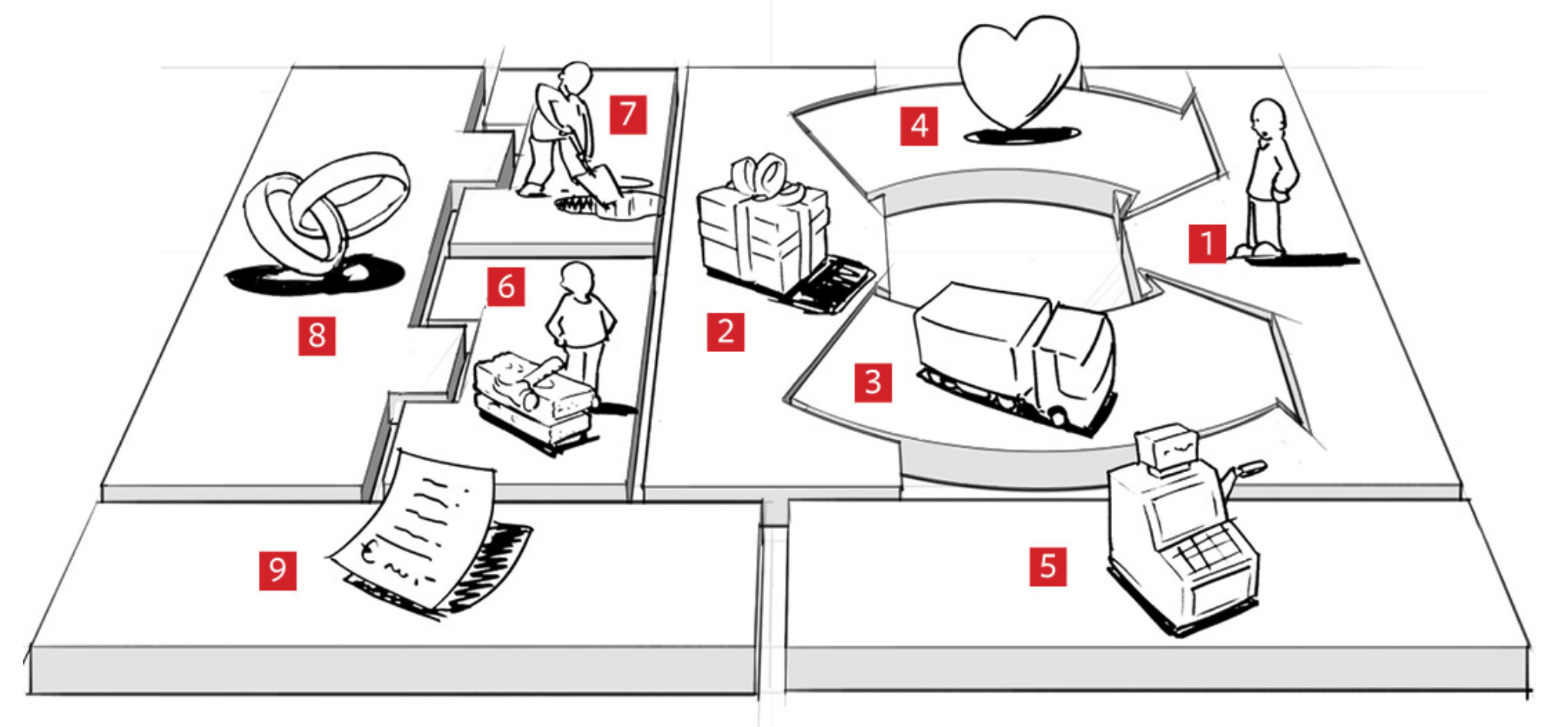
a mental model to help you conceptualize, explain and improve key components of your business.
Mental Model
A mental model is a representation of the world or of how something works.
Why Mental Models Matter
“The inverse of being right more is being wrong less. Mental models are a tool set that can help you be wrong less.”
Gabriel Weinberg and Lauren McCann’s book on mental models, Super Thinking
Fans of Mental Models include Warren Buffet and Charlie Munger among others.
Customer Development
a process to organize the search for a business model, find product-market fit, understand your customers, etc.
Originated with Steve Blank and popularized by Eric Reis and Lean Startup. Dovetails well with many aspects of UX.
Two Phases of Customer Development
- Customer discovery = “acquiring a deep understanding of customer needs”
- Customer validation = process to invalidate/prove other aspects of your biz model like sales desire and traction channels
Pivot
- Change in one of more business model components
Eric Ries / Lean Startup: a “structured course correction designed to test a new fundamental hypothesis about the product, strategy, and engine of growth.”
Product-Market Fit
“Product/market fit means being in a good market with a product that can satisfy that market.” - Marc Andreessen
“You have built a product that creates significant customer value. This means that your product meets real customer needs and does so in a way that is better than the alternatives.” - Dan Olson
Short Version: Delivering a product or service to a customer segment that really wants it, will buy it and even recommend it.
Goal is Demonstrable and Repeatable Growth
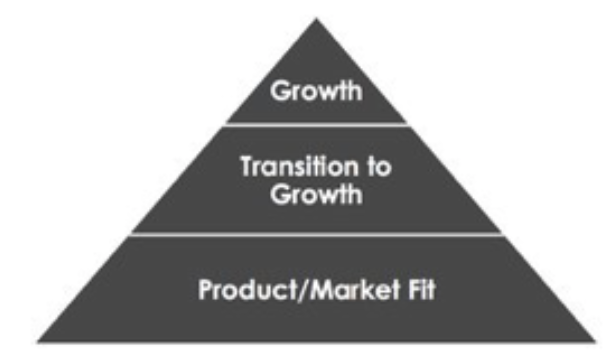
Reach Product-Market Fit before you focus on growth and traction.
In practice, startups begin with a set of initial hypotheses (guesses), most of which will end up being wrong. Therefore, focusing on execution and delivering a product or service based on those initial, untested hypotheses is a going-out-of-business strategy.
Steve Blank
Business Model Canvas
What is BMC?
- The business model canvas is a thinking and strategizing tool for working on your business.
- At a high-level, it helps you think about a business through several key components that make most businesses work.
Form
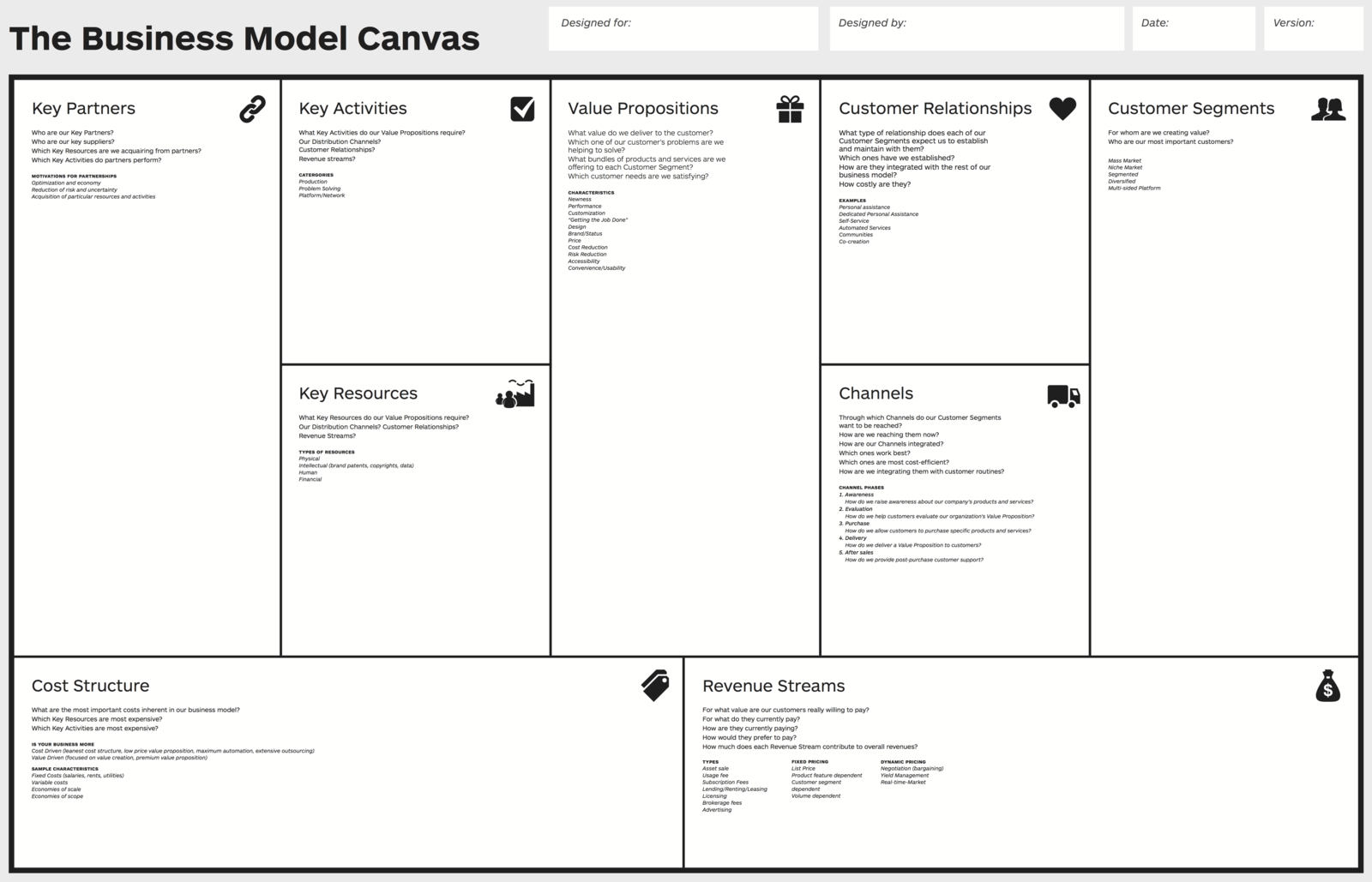
9 Components of BMC
- Value Proposition
- Customers
- Customer Relationships
- Channels
- Key Activities
- Key Resources
- Key Partners
- Cost
- Revenue
Benefits of BMC
Describe what a business does, i.e. externalize key aspects of your (possible) business components.
Pin-point assumptions that you might want to explore through customer discovery research and design (often referred to as UX Design) or better yet attempt to validating those components in the market.
Help you tell your story.
Customer Development Principles
Objective of Customer Development
Turn assumptions and guesses into facts and knowledge ASAP.
How-To Customer Development =
Talk to customers.
Markets with…
- Invention / Technology Risk (questionable if tech can be done or invented).
- Customer/Market Risk (unknown if customers will adopt and/or pay product/service)
Customer Development Process
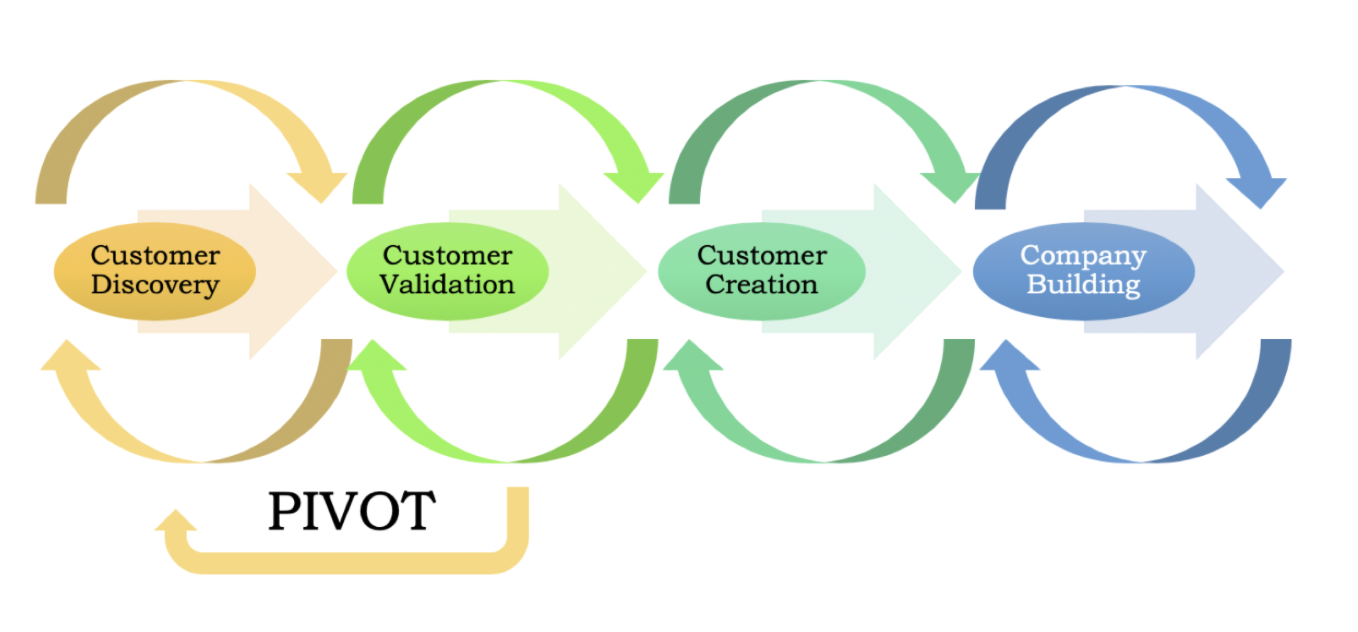
Customer Discovery Process
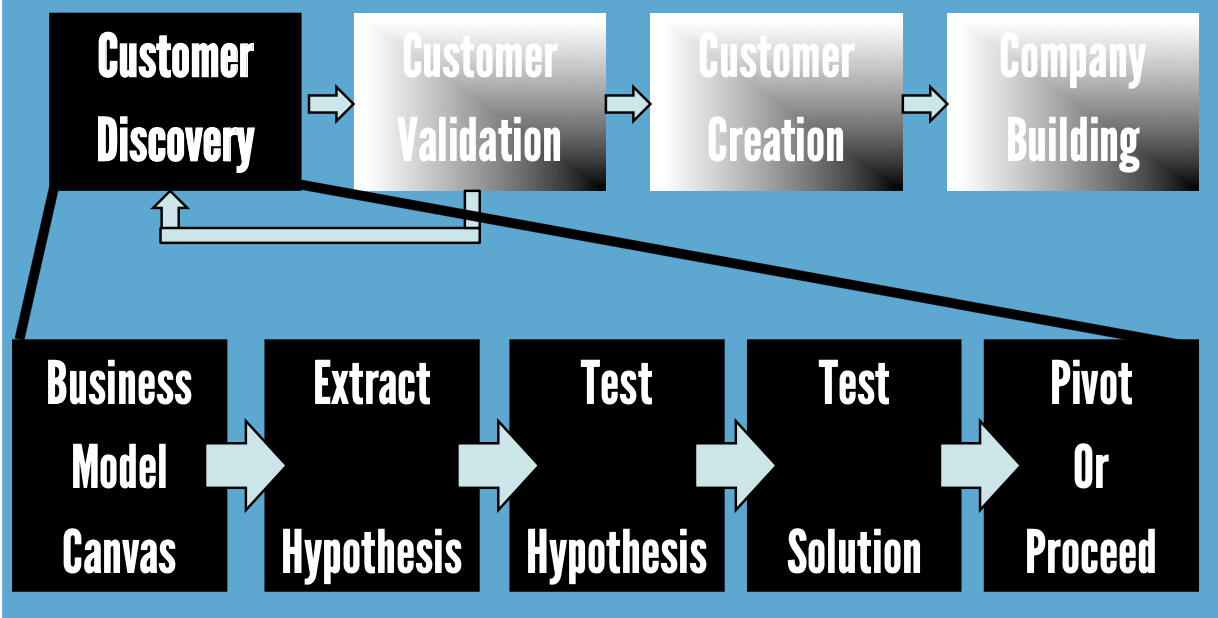
Customer Validation Process
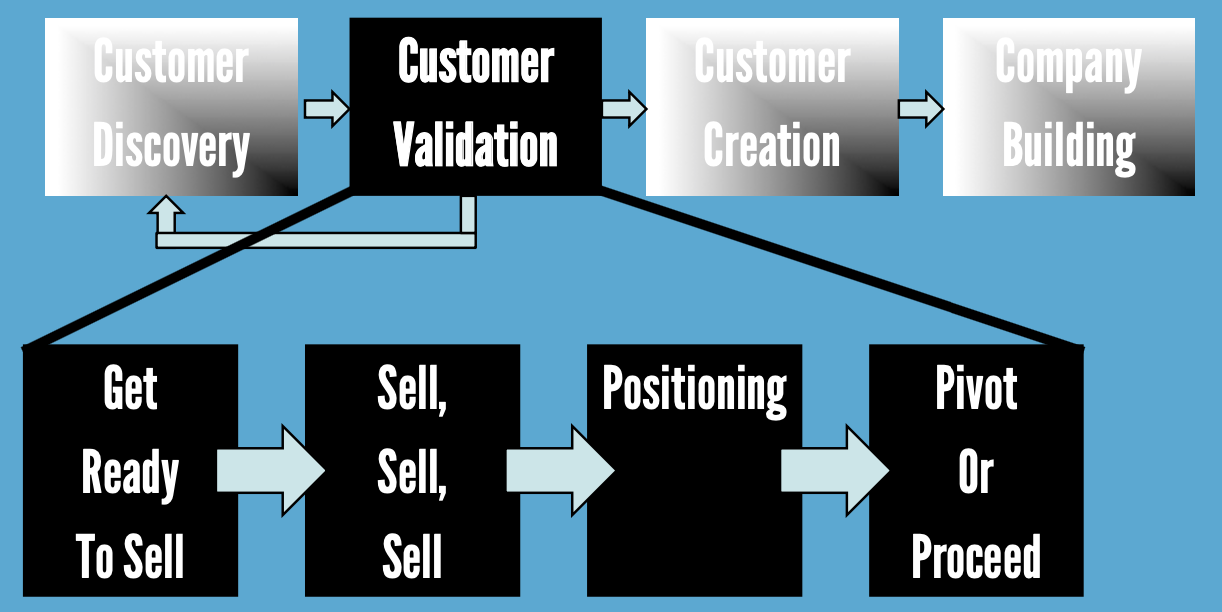
The key to customer discovery…
TALKING
to customers
By understanding the problem, you can…
Understand the solution.
Customer Development Tactics
Own your assumptions.
- What are your assumptions that, if invalidated, will break the business?
- Business Model Canvas = use to lay out your key assumptions to test
- Market Sizing = talk to customers from your target markets, use to explore definition of markets (overall, addressable and target)
Get out of the Building.
Focus on learning and helping, rather than selling
Customer Interview
- Person
- Problem
- Solution
MVP House
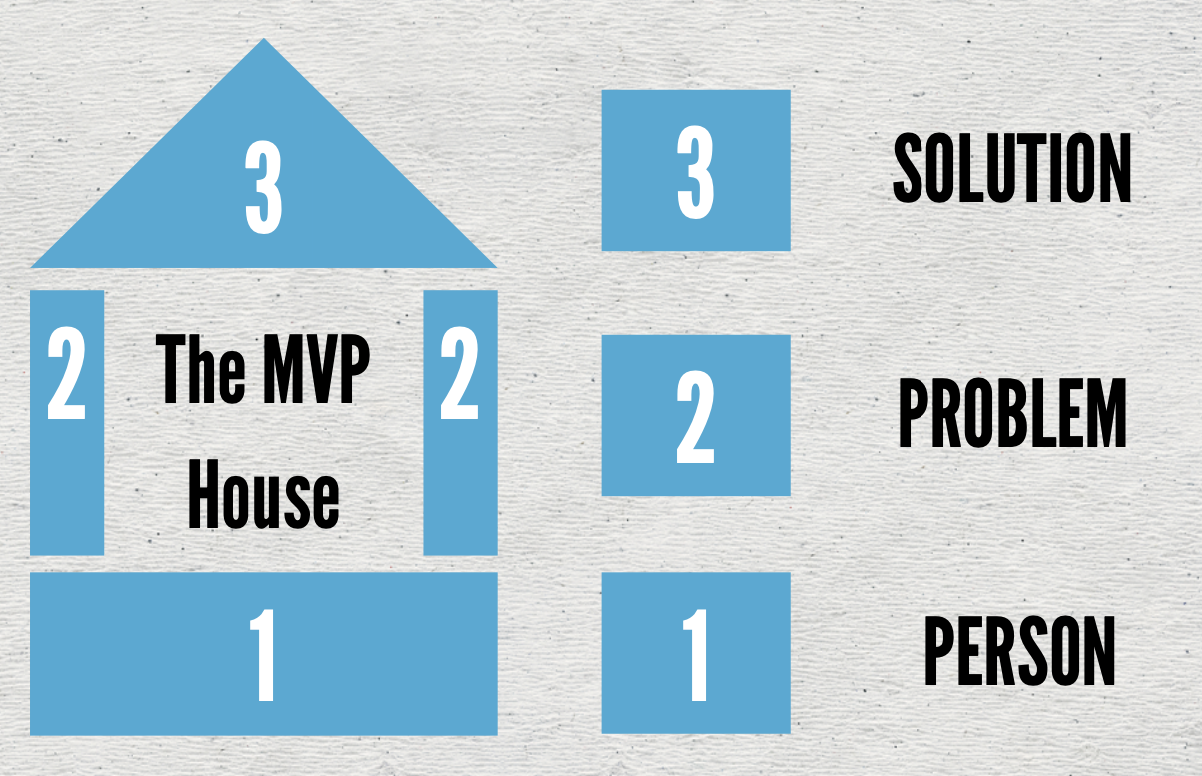
1. The Person
- Who are they? What is their role? Backgound? Etc.
- If business product, who is their boss? who works for them?
- What is a typical day like? How do they spend their time?
Goal: Get a broad background understanding of the person. Develop a relationship. Stay broad.
2. The Problem
- Learn about the problems that person recognizes and verbalizes.
- What are the top three challenges they face?
- What is frustrating, expensive or time consuming?
- What would they change right now?
- How are they solving them? Competitors? DIY tools and workarounds?
Goal: Get them to verbalize the problem you want to solve (preferrably unprompted)
3. The Solution
- Assuming you’ve gotten them to identify with your problem, then…
- Reveal your solution (either as a concept or prototype or product)
- Read their reactions as well as their words to capturee their level of interest.
- HINT: “That’s interesting” = kiss of death
Goal: Discover if they want your solution and gather feedback.
Tips for Customer Interviews (1)
- Turn assumptions into customer questions.
- Create a script of your key questions.
- Work as team (customer development is the job of entire founding team).
- Take detailed notes (and consider recording)
- Use a Google form to log key responses.
- Be empathetic with interviewee and go off script when needed.
- If they are excited about something, ask if they’ll pay for.
Tips for Customer Interviews (2)
- Be open-ended.
- Show them early prototypes (if you have them and if they indicated a desire for it).
- Always follow-up.
- End with an ask (intro to someone else to interview, join mailing list, etc.).
- Review and Summarize, esp Extract key quotes and look for patterns and clusters
- Be open to new problems and opportunities.
Iterate: Focus or Pivot.

Where to find people/prospects to interview?
- Tap your social and professional network
- LinkedIn, Email, contacts, etc.
- Expect a higher response (30-40%)
- Meetup Groups, Twitter, Facebook Groups, Reddit, Craigslist, Instagram, etc.
- Expect a lower response rate (10-20%)
- Consider offering payment/gift card for an interview
How Many Interviews?
- As many as needed to in/validate assmptions.
- DISCOVERY TIP: Aim to do 8-10 interviews for each customer type
- UX TIP: Customer Discovery can be combined with and supplement user testing.
Debrief, Review and Summarize
Keep a Living “Customer Research” report
Track your assumptions…
- Google Doc / Spreadsheet / Airtable of all assumptions and hypotheses to validate and test.
- Record the status.
- Rank their importance (i.e. if invalidated, does it invalidate entire business?)
- Link to interviews you do and experiments you run.
TIP: Validation Board from Lean Startup Machine.
Run Lean startup / marketplace experiments
- When in doubt, don’t assume. Instead, test it!
- Examples:
- Value hypothesis test = sell to target customers
- Growth hypothesis test = experiment with traction methods
Customer development is about more than the customer.
It’s about exploring the dimensions of your business model and ecosystem in an inexpensive, agile and opportunistic way.
It’s about testing the validity of your most important assumptions.
It’s about dealing with your uncertainties.
Example
- Finding, Understanding and Selling Sponsorship Customers for Up Global and Techstars in China (2014-2016)
- Assumptions from US
- What I Did
- Discoveries / Lessons Learned
Resources / References
Resources and Book Recommendations
- David Rose - The Startup Checklist. (2016).
- Gabriel Weinberg - Traction: How Any Startup Can Achieve Explosive Customer Growth
- Dan Shapiro - Hot Seat (2015).
Organized Mind by Daniel Levin & Getting Things Done by David Allen
Summary
All startups face uncertainties.
Customer Development is intended as a systematic process towards dealing with uncertainty and reaching product-market fit (i.e. products that matter, get traction, grow, have sales that VC want to invest in).
Summary
- Do a lot of customers interview.
- Use the business model canvas to own your assumptions and learnings. Then communicate, validate, and build your story.
Matching a product with its target customer is like fishing. Your product is the bait that you put out there and the fish that you catch is your target customer. Sometimes you catch the type of fish you were going after and sometimes you catch a different type of fish….
Dan Olsen
…You can develop hypotheses about your target market, but you won’t truly know who your customers actually are until you throw your hook into the water and see what kind of fish bite.
Dan Olsen
Thanks
Find me online at www.markwk.com!